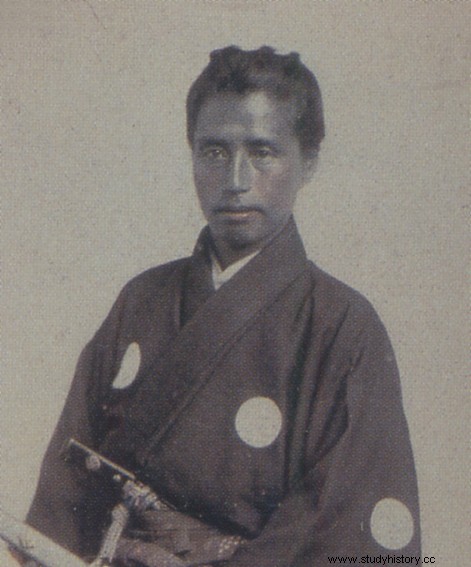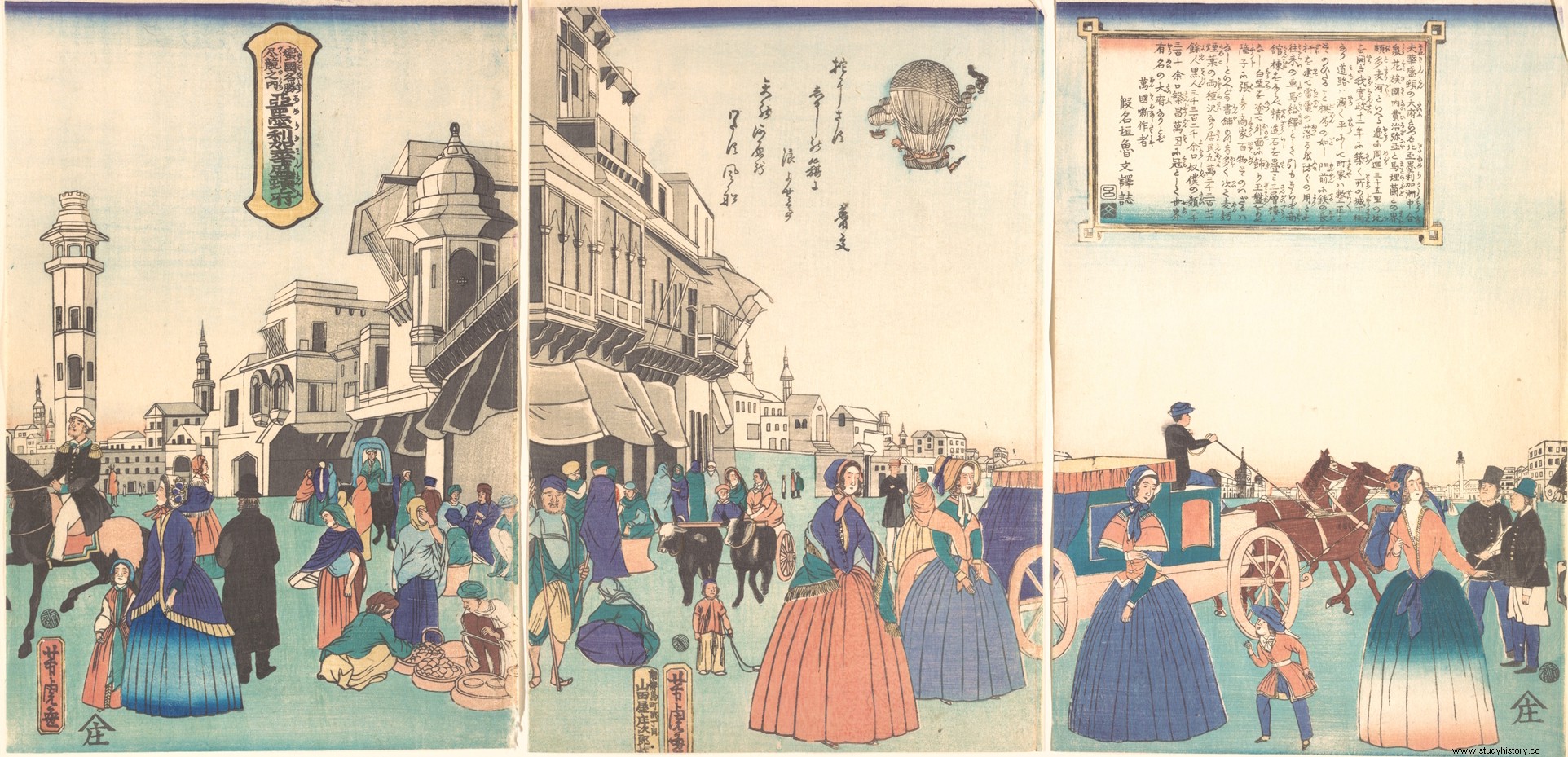Residents of mid-19th-century San Francisco were used to seeing all kinds of quirky characters on their streets. The gold rush was on its last legs and a veritable tide of outlaws, settlers, opportunists, and people of the most diverse stripes had flocked like flies to honey, attracted by the promises of golden California. But nothing compared to that guy who prowled the alleys of Barbary Coast , the city's red light district, on that March day in 1860. That one must have seemed like a real weirdo to the locals. And it was not for less, in those lands a samurai had never been seen, not even in painting. In fact, no one in the entire West had seen a samurai in the last 300 years. But there she was, strolling through the most populous city in the Wild West with her swords at her belt, silk kimono, straw sandals and slicked-back bow. His name was Katsu Kaishu , and he had just arrived in the US heading the diplomatic mission that the Japanese government had sent to America. That was the first delegation that Japan had sent to any country since the 17th century, and its members were, therefore, the first Japanese to venture outside its borders in a couple of centuries. Hard to imagine someone more out of place than good old Katsu in the middle of the Californian city.

Katsu Kaishu during his visit to the US
Japan lived at that time under the iron regime of the Tokugawa Shoguns , which had held the empire together and completely isolated from the outside world for nearly 250 years. Until, in 1853, the outside world came knocking at the door in the form of American warships. The fleet of Commodore Perry stood in the middle of Edo bay (present-day Tokyo) with the firm intention of "inviting" the Japanese to open their ports to international trade, and the Shogunate had no choice but to comply with their demands. The alternative, needless to say, was to be gunned down by modern Yankee battleships, gigantic steel ships that must have seemed to the Japanese, still in the Middle Ages, as if they had come out of hell itself. And so Japan saw how, overnight, its cities were filled with foreigners with absurd customs, poor hygiene and even more strange technology. The culture shock shook the very foundations of the nation, and soon the revolutionary echoes began to resonate with force. The arrival of Perry and his black ships had lit a fuse that would eventually unleash a firestorm the likes of which had never been seen before. The era of the samurai was drawing to a close, and the nearly three centuries of Pax Tokugawa they were to come to an abrupt and bloody end.
But now, in 1860, we are still at the dawn of that revolutionary process. Let's go back to that samurai who roams the streets of San Francisco. Katsu Kaishu , an iconoclastic and open-minded man unusual among his contemporaries, he was convinced of the need to learn from Westerners. Aware of Japan's backwardness and her inferiority before foreign powers, he advocated abandoning the old schemes and modernizing the country. Only in this way could he preserve his independence and avoid the sad fate of China, which at that time was already beginning to bleed to death under the European colonial yoke. Fortunately for him and for the future of the nation, certain bigwigs in the Shogunate felt the same way, and that gave Katsu, a samurai from a humble family, the unexpected opportunity to rise through the ranks. He was sent to Nagasaki to study with Dutch naval experts and, as a result of that experience, he ended up as captain of the Kanrin Maru , the ship that would take the first Japanese delegation to the United States. The ship sailed from Yokohama in February 1860 escorted by the USS Powhatan , to arrive the following month in San Francisco. The Kanrin Maru would be the first Japanese ship to cross the Pacific , quite a feat, although Captain Katsu, rather frail of complexion and prone to seasickness, did not have a great time at the mercy of the high seas winds and storms.
The objective of the mission was, officially, to ratify the treaties signed with Perry the previous five years, but for Katsu it was a golden opportunity to get to know those fearsome foreign barbarians better, to study them on their own ground. He was dying to see with his own eyes how Americans lived, what their cities were like, how tall their buildings were. He was also intrigued by what foreigners called Constitution . He was attracted by American democracy, the idea of government by the people, citizen rights… he even fantasized about introducing such concepts in his country. No, Katsu hadn't braved the seas and come to America to stay locked up within the four walls of the hotel.

The West seen by the Japanese of the XIX
And what better place to meet the man in the street than the city slums? Neither short nor lazy, without any escort and armed only with his samurai sabers, Katsu ventured into the slum maze of the Barbary Coast . Although, by dint of being honest, the herreruza wouldn't be of much help in a pinch either. Katsu was a master swordsman, yes, but he didn't like to draw his blade lightly. Always a believer in pen over sword, Katsu was better at resolving conflicts with words. Half jokingly, half seriously, he used to comment that his katana had been stuck in its sheath for so long that it would be impossible for him to unsheathe it even if he wanted to.
But, in the red light district of San Francisco, among streets with names as evocative as Murder Point or Dead Man's Alley , and taking into account that he barely spoke a couple of broken sentences in English, it was not very likely that good old Katsu was going to get away with a more than possible altercation just with his flowery verb. Katsu blended into such surroundings like an octopus in a garage…and we all know what ends up happening when a strange-looking stranger breaks into a Far West saloon. Be that as it may, cowboy movies hadn't been invented in 1860, so Katsu, unaware of the customs of the place, didn't think twice and strode purposefully into one of those seedy saloons. Since his English was not enough for much more, he ordered a beer, sat down at a table and began to drink quietly oblivious to the astonished looks of those around him. Although, to be fair, the thing was more of a draw because, in the eyes of a man who came from medieval Japan, that den of perdition must have seemed as strange and abracadabra as the planet Mars itself.
A samurai in the middle of the American West was not something you saw every day, but Katsu not only drew attention for his outlandish clothing. He, too, was an attractive man, and apparently our exotic stranger had a crush on one of the local girls. An exuberant blonde girl in a tight dress with a generous neckline and a derringer hidden in the gutter, just in case. The typical young lady of the West. As the canons of her trade dictate, the girl, very perky, sat down next to her and began to chat. It couldn't have been a very memorable conversation, given Katsu's mastery of the language of Shakespeare, but the girl put her will. Until, in true Far West style, it didn't take long for someone to get in the way. A big, ragged guy almost two meters tall; a rude and smelly miner with a red beard, a revolver on his belt and a trapper's machete tied to his leg. A real freak. The attentions that the girl gave the stranger did not seem to please the bouncer, who leaned on Katsu's table and began to blurt out in a thick mountain accent. The samurai continued to drink the beer impassively, with the girl sitting next to him. It is true that those threats did not matter to the warrior of the rising sun, who did not understand a word, but the bigard's threatening gestures left little room for doubt. The thing was getting more and more ugly and the pelandrusca, seasoned in this type of vicissitudes, ended up using her little derringer and pointing the gun at the meddler. Katsu saw that it was time to take action on the matter, but for that reason he did not alter his gesture in the least. He just took a silver dollar out of his wallet, ordered another beer, and invited the behemoth to share a table with them. The absolute calm of that little oriental man, his imperturbable composure and, above all, the fire that gave off his gaze, disarmed the gigantic miner. Like a wild animal dominated by the will of his tamer, he could not help but surrender to this strange stranger and sit down at the table to drink with him. Without even moving to brush the hilt of his sword, Katsu had subdued his enemy.
It wouldn't be the last time Katsu escaped certain death by the sheer force of her charisma and his word. Katsu lived through turbulent times, and this type of episode abounds in his biography. Certainly, a life as romantic as his would fill several books with anecdotes. After coming out of this adventure in the underworld of San Francisco in one piece, he would return to Japan to become a mentor to revolutionaries, an industrial entrepreneur, a visionary politician, founder of what would be the germ of the future Imperial Navy... and several dozen other things. plus. A multifaceted guy, this Katsu. In the following years, after a long period of convulsions and civil war, Japan would end up overthrowing the Shoguns, abolishing the feudal system, returning absolute power to the emperor and definitively entering the modern industrial age. And Katsu Kaishu, the quiet man, the samurai who never drew his sword, was called to be one of the main actors in that great drama.
Collaboration of R. Ibarzabal .
Sources:Samurai Tales:Courage, Fidelity and Revenge in the Final Years of the Shogun – Romulus Hillsborough
